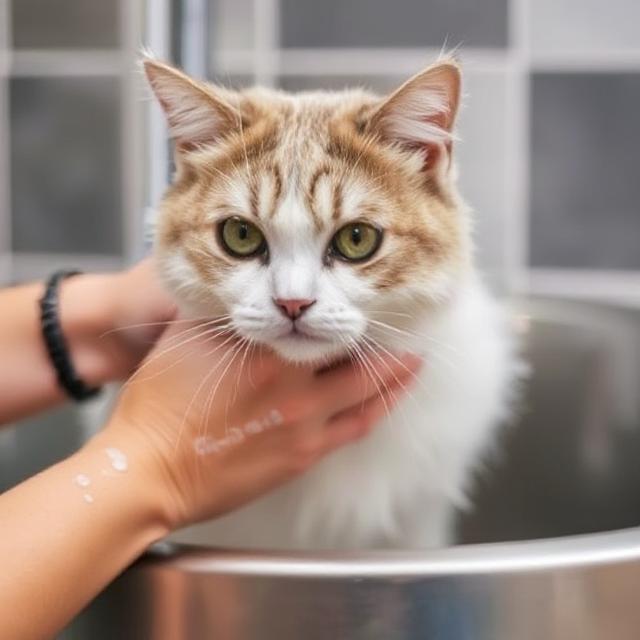How To Bathe a Cat Without Getting Scratched
How To Bathe a Cat Without Getting Scratched: A Complete Guide for Cat Owners
Bathing a cat can feel like a mission impossible — claws, hissing, and panic everywhere! If you’ve ever tried giving your feline friend a bath, you already know how stressful it can be for both of you. Cats are naturally clean animals and often groom themselves, but sometimes, a bath is necessary. Maybe your cat rolled in something sticky, or perhaps your vet advised a medicated wash. How to bathe a cat without getting scratched
Whatever the reason, learning how to bathe a cat without getting scratched is an essential skill for any cat owner. The good news is that with the right preparation, calmness, and gentle technique, it can be done — safely and even peacefully.
This detailed guide will walk you through step-by-step instructions, expert tips, and precautions to ensure you and your cat survive bath time without injuries.
1. Understand Why Cats Dislike Water
Before diving into the “how,” it’s important to understand why most cats resist baths. Cats usually dislike water because: How to bathe a cat without getting scratched
-
Their fur doesn’t dry quickly, making them feel cold and heavy.
-
They lose control during water contact, which triggers stress or fear.
-
Their natural grooming instincts already keep them clean, so water feels unnecessary.
Understanding this behavior helps you approach the bath with empathy and patience rather than frustration.
2. Gather All Supplies Before You Begin
Once you start bathing your cat, you won’t have time to run around looking for shampoo or towels. Preparation is key to a calm and quick process.
Here’s what you’ll need: How to bathe a cat without getting scratched
-
Cat-friendly shampoo: Never use human or dog shampoo; it can irritate a cat’s skin. Choose a vet-approved or hypoallergenic cat shampoo.
-
Two towels: One for drying your cat and one for extra grip on surfaces.
-
A cup or handheld sprayer: To gently pour water.
-
Rubber gloves: To protect your hands from scratches.
-
Cotton balls: To protect your cat’s ears from water.
-
A non-slip mat: To prevent slipping inside the tub or sink.
-
Treats: To reward and calm your cat during and after the bath.
Having everything within arm’s reach makes the whole process smoother and safer.
3. Trim Nails and Brush the Fur First
One of the best ways to avoid scratches is to trim your cat’s claws before the bath. Use a proper cat nail clipper and trim just the sharp tips — not too deep. This small step can save your arms from painful surprises. How to bathe a cat without getting scratched
Next, gently brush your cat’s fur to remove any tangles, dirt, or loose hair. If your cat has long fur, brushing prevents matting when wet and makes drying easier later.
4. Choose the Right Location
Where you bathe your cat can make a huge difference. A sink, basin, or small tub is usually better than a large bathtub, as cats feel more secure in smaller spaces.
Make sure the area is: How to bathe a cat without getting scratched
-
Warm (but not hot)
-
Quiet and free from distractions
-
Close to a door you can close (in case your cat tries to escape)
Place a non-slip mat or towel at the bottom of the sink to give your cat grip and comfort.
5. Prepare the Water Temperature
Cats are sensitive to temperature changes, so always test the water first. It should be lukewarm — not cold, not hot. A temperature around 37–39°C (98–102°F) is ideal. How to bathe a cat without getting scratched
Fill the sink or tub with just a few inches of water. Cats don’t need to be fully submerged — that will only increase anxiety. The goal is to clean them gently, not to soak them.
6. Keep Calm and Handle Gently
Your attitude sets the tone for the entire experience. Cats can sense tension easily, so speak softly, move slowly, and avoid sudden actions.
If your cat is very anxious, wrap them loosely in a towel and gradually wet one area at a time. Some owners even use calming sprays or pheromone diffusers before starting. How to bathe a cat without getting scratched
Hold your cat gently but firmly — enough to prevent escape, but never in a way that causes pain or panic.
7. Wet the Fur Slowly
Start by gently pouring water on your cat’s back using a cup or handheld sprayer. Avoid the face, ears, and eyes for now.
Talk to your cat in a calm voice throughout — it helps reassure them. Work from the shoulders down, wetting only a small area at a time.
If your cat starts panicking, pause for a moment. Give them a break and try again when they seem calmer.
8. Apply Cat Shampoo Properly
Once your cat’s fur is damp, take a small amount of cat shampoo and lather it gently into the fur. Avoid using too much; cats have thinner coats than dogs, and a little goes a long way. How to bathe a cat without getting scratched
Massage the shampoo from the neck down, working it through the body and tail. Be careful around sensitive areas like the belly and legs. How to bathe a cat without getting scratched
Tip: Never wash your cat’s head directly with water or shampoo. Use a damp cloth to gently wipe the face instead.
9. Rinse Thoroughly
Shampoo residue can irritate your cat’s skin if not rinsed properly. Use a clean cup or sprayer to pour lukewarm water over the fur until all the soap is gone.
Make sure you rinse carefully under the legs and along the belly. It might take a few rounds of pouring water to remove all the bubbles — but it’s worth the effort.
10. Dry Your Cat Quickly and Comfortably
Immediately after the bath, wrap your cat in a clean towel and gently pat them dry. Avoid rubbing harshly, as it can cause tangles or irritation.
If your cat tolerates it, you can use a hairdryer on a low, warm setting, but keep it at least 12 inches away and watch for signs of distress. Most cats prefer towel drying followed by air drying in a warm, draft-free room. How to bathe a cat without getting scratched
Make sure your cat stays indoors until completely dry to avoid chills.
11. Reward and Reassure
Once the bath is over, praise your cat and give them treats. This helps them associate bath time with positive experiences. How to bathe a cat without getting scratched
A calm tone, gentle petting, and maybe even playtime afterward can help your cat recover from the stress — and make the next bath easier.
12. Alternative Options for Water-Hating Cats
If your cat absolutely refuses to be bathed, don’t worry — there are alternatives:
-
Waterless cat shampoos: Foam or spray formulas that clean without water.
-
Cat wipes: Pre-moistened wipes that remove dirt and odor.
-
Professional groomers: Some specialize in cats and know how to handle them safely.
These options are great for cats that experience high anxiety or aggression around water.
13. Safety Tips to Avoid Scratches and Stress
To keep both of you safe, remember these essential precautions: How to bathe a cat without getting scratched
-
Never force your cat into the water — go slow.
-
Keep their head above water at all times.
-
Avoid the face and ears; water in these areas can cause infections.
-
Use gloves if you’re nervous about scratches.
-
Always have a towel ready before you begin.
A calm, confident owner equals a calmer cat.
Final Thoughts
Bathing a cat doesn’t have to be a nightmare. With the right approach, patience, and preparation, you can bathe your cat without getting scratched — and maybe even make it a bonding experience. How to bathe a cat without getting scratched
Remember, every cat is different. Some may tolerate baths easily, while others may need extra time and care. Always prioritize your cat’s comfort and safety over perfection. How to bathe a cat without getting scratched
With each gentle bath, you’ll build more trust — and who knows? Your feline friend might one day surprise you by purring through the process!


